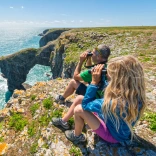Cormorants on Anglesey
Where to see them: Puffin Island, Anglesey, North Wales
As well as sheltering grey seals, Puffin Island is home to a huge colony of cormorants – for which the island is a Special Protection Area. A supreme fisher, these marine birds are a sight to see on the cliffs of island. There are also increasing numbers of puffins here and you may see black guillemots and harbour porpoises. Boat tours around the island are available throughout the summer from Beaumaris pier - Starida, Seacoast Safaris and Seawake all offer island trips.

Gannets on RSPB Grassholm Island
Where to see them: coastal areas, especially near RSPB Grassholm Island, Pembrokeshire
These bright white seabirds are a common sight around the Welsh coast and you’ll know them for their plunging dives from great heights. One place you’re sure to spot them is around the coast near RSPB Grassholm Island in Pembrokeshire. That’s because this tiny piece of rock is home to the third largest colony of gannets in the world – roughly 39,000 pairs.

Arctic terns at Cemlyn Nature Reserve
Where to see them: North Wales coast
White with a black cap, the arctic tern is also known by its local name ‘sea swallow’ and they really are extraordinary birds. Arctic terns can live up to 30 years. And in their long life scientists reckon they make the equivalent of three round trips to the Moon. North Wales is the best place to spot them, particularly the Cemlyn Nature Reserve on Anglesey.


Manx shearwaters and puffins on Skomer Island
Where to see them: Skomer Island, Pembrokeshire, West Wales
Anyone walking round the Wales Coast Path should keep their eyes peeled for the Manx shearwater – although they may not have to look too hard. Wales has half the world’s population, with Skomer Island, Pembrokeshire supporting 120,000 breeding pairs and Ynys Enlli (Bardsey Island), just off the Llyn Peninsula, home to a further 16,000 pairs. This medium sized seabird is black on top and white below and has a distinctive ‘shearing’ form of flying, with stiff wings and few wing beats.


Bearded tits on RSPB Newport Wetlands
Where to see them: RSPB Newport Wetlands Reserve
Despite its name, this brown, long-tailed bird is a ‘parrotbill’, not a close cousin of our familiar blue and great tits. The ‘beard’ refers to the black markings on the male’s face (although they look more like handlebar moustaches). Found only in reedbeds, bearded tits have a small population of around 630 breeding pairs in the UK, mainly in the east of England, but recently the RSPB Newport Wetlands Reserve has become home to them.

Chough on RSPB South Stack Cliffs
Where to see them: from Pembrokeshire to Anglesey
The chough’s Welsh name, Brân Goesgoch, literally means ‘red-legged crow’ – and that’s what it is. Usually seen along the coast, the chough is the rarest member of the crow family. The UK has just a few hundred pairs, with three-quarters of them living in Wales. You may hear them before you see them though – they have a distinctive call. A great place to find them is at the RSPB’s South Stack Cliffs, in North Wales.

Red kites at Gigrin Farm
Where to find them: mainly in the Mid Wales
One of the best places to see red kites is Mid Wales, although they have spread from their stronghold out to areas of the coast, particularly Ceredigion. Keep your eyes open wherever you are, and if you want the quintessential kite experience, peel off the path and head inland to see them being fed at Gigrin Farm near Rhayader, or flying at Bwlch Nant Yr Arian in Ponterwyd.


Ospreys in Mid and North Wales
Where to find them: Glaslyn Estuary or Dyfi Valley
Ospreys are one of the most recent, and certainly one of the most spectacular, birds to recolonise Wales. Your chances of seeing one along the route of the Wales Coast Path are much enhanced by visiting the Dyfi Wildlife Centre at Cors Dyfi (run by Montgomeryshire Wildlife Trust) near Machynlleth. Further north, the Glaslyn Osprey Project is based at Pont Croesor in the Glaslyn Valley.
Stonechats on the Glamorgan Heritage Coast
Where to find them: anywhere along the cliffs – try the Glamorgan Heritage Coast
This little bird is a common sight on the Welsh coast as they thrive in coastal vegetation. The adult male has a distinctive black head and, while the birds are sometimes shy, they do love to let you know they’re around. In fact, you may well hear a Stonechat before you see one, listen out for a sharp, loud call, like two stones being tapped together. They can be found along the cliffs and shingled stretches.


Peregrine falcon at Cardigan Bay
You’ll need all your wits about you to hone in on one of these beautiful birds of prey, Britain’s largest falcon. That’s because the peregrine is one of the fastest animals on earth, reaching speeds of 200 miles per hour while diving for prey. Peregrine falcons thrive in coastal areas (as well as, increasingly, urban centres) – and while you might encounter one anywhere along the coast, the beaches of Mwnt and Llangrannog in Cardigan Bay are great places to start.





